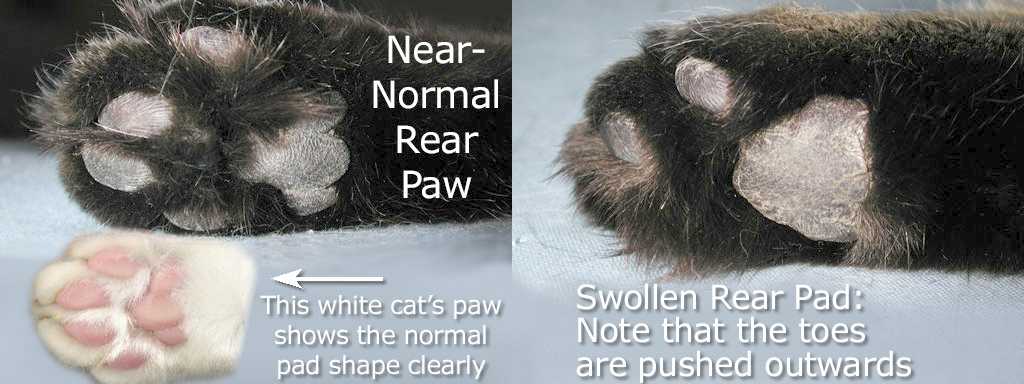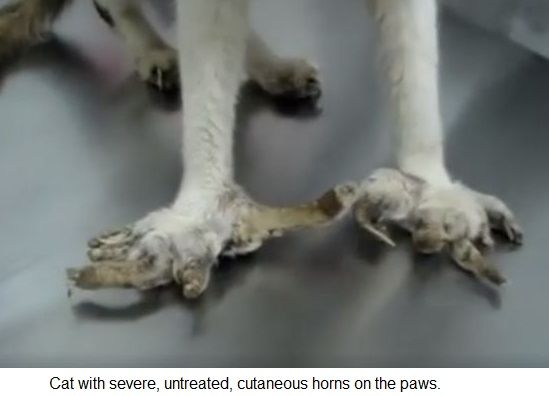
HORNED PAWS
"Horned" paws can have various different causes. The simplest cause I have seen is the formation of calluses – hardened skin caused by repeated friction. These can be filed down if the cat doesn’t protest. It’s not advisable to clip calluses in case you accidentally clip the soft skin underneath. I’ve seen these in cats that like to climb or play on brick walls or concrete paths.
Another cause is a cyst where the contents exude very slowly and harden on contact with the air. The cyst is a pocket containing skin cells which are trapped in the pocket when they are shed. These horns grow from the base as the cyst contents are slowly released. Although these horns can be knocked off accidentally, they will continue to grow until the underlying cyst sac (which sheds the cells) is removed.

Most commonly, in cats at least, cutaneous horns are an overgrowth of keratin – the same material that forms hair and nails – and affect one or multiple paw-pads. They usually resemble second claws or close to the true claws. These generally don’t cause any discomfort unless they are on a weight-bearing part of the paw-pad, but they can cause clicking sounds when the cat walks on hard surfaces such as floorboards. If they occur on a weight-bearing part of the pad they can cause lameness.
Cutaneous horns tend to occur spontaneously on the paw pad. In outdoor cats they are probably worn away as fast as they grow and go unnoticed. If they resemble second claws just below the true claws the vast majority are harmless. If the horns are not causing lameness they can be ignored or periodically trimmed. If they cause discomfort or lameness the vet will advise on whether the growth can be removed without adversely affecting the paw pad.
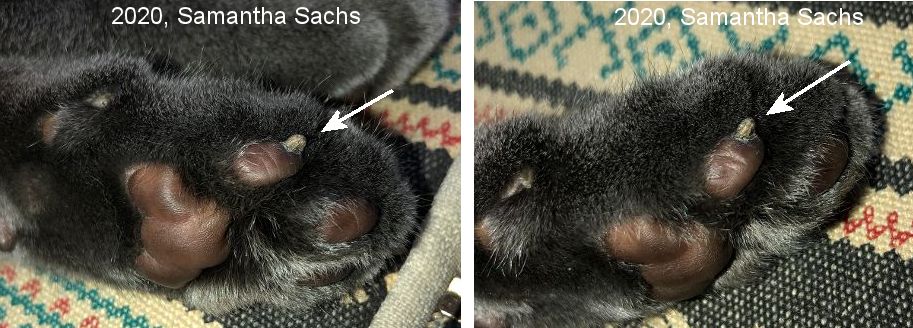
Some types of cutaneous horns are also associated with papillomavirus infection, actinic keratosis, FeLV, and squamous cell carcinoma. These are rare and look different from the horned pads shown here. FeLV-related paw pad horns occur in the centres of the paw pads, while non FeLV-related horns grow on the toe pads, just below the nails. If you are worried, FeLV can be ruled out easily by a test. Single horns in combination with scaly skin lesions should be biopsied to rule out squamous cell carcinoma.
In Feb 2019 Bradley Morgan sent me photos of his 5 month old kitten’s horned toe pads. Some of the “horns” have since fallen off. The way these stick out from the pad suggests “cutaneous horns” where a cyst very slowly releases its contents which then dry out when exposed.

The horned paw pad anomaly was is anomaly was reported by owner Sandi A Surace in December 2002. Her 16 week old polydactyl kitten, Sassy, who had been bottle raised from 2 weeks old, has a thumb on both front paws. In between the thumb and the "regular" digits, she also has 2 smaller additional toes, complete with retractile claws. These extra digits are smaller though. In addition to these, the kitten has what appears to be tiny claws growing our of the terminal pads of the paws (the "fingertip" pads). Two of these were already 2mm long, made of claw-like material and pointed like claws. These turned out to be horny growths from the paw pads - something sometimes seen on old cats, but rare in kittens. Unlike claws, these growths have no quick (the pink sensitive "core" of the claw) and Sandi clips Sassy's "horns". If they become a problem e.g. snagging on furnishings, they will be surgically removed. These "horns" are not associated with the polydactyl condition, so Sassy is probably unique.
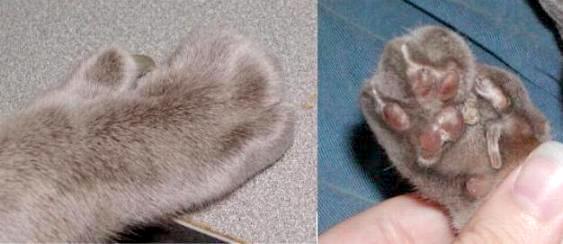
In October 2003, Seby Bell wrote of her 2 month old kitten "Morris" who also has claw-like or horny growths on his paws. Morris has otherwise normal feet and toes, but each toe, including the pad of the dewclaw, has what looks like a tiny stunted claw underneath. Morris's father has exactly the same growths on his paws so it looks to be an inherited trait.
Seby wrote that the growths don't appear to be attached to bone, which might rule out extra toes, unless they are floating toes (as with dewclaws on some dogs). There are two things which make the growths appear especially "claw-like" - they are slightly indented in the tip of each pad, rather than flowing straight out from the pads, and the growing tips are more clear than the base. Seby was concerned about clipping these growths in case of bleeding, but if they grown longer they will definitely need trimming or filing! The growths don't appear to hamper Morris's movement and he uses the scratching post regularly which might also keep the growths rasped down. They do indeed look just like "upside down" claws as some of them appear to be curving slightly upward toward Morris's regular claws. Seby is not sure how much they will end up doing this.
Morris's father is believed to be "half Manx" and is a blue-eyed white longhair with a Manx body-shape and "cropped" tail. The owner said this cat had "an extra set of claws which grow upside down under his regular claws" although Seby didn't get to see this for herself. The owner didn't mention that any of the kittens also had this feature, and Seby didn't find this out until she got Morris home. She is hoping to visit the white cat's owner again to see how the growths progress (these were apparently never removed on that cat) so she knows what to expect with Morris and whether Morris's father's owner trims or files the growths.
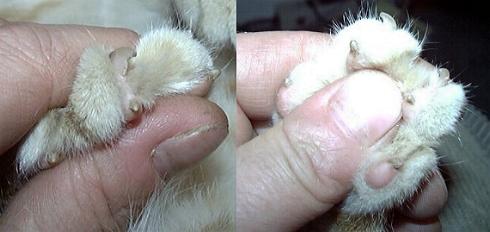
Although it is impossible to tell exactly what they are from photographs and without a hands-on examination (which hopefully a vet will provide in due course, possibly with an X-ray) these may be horny outgrowths from the paw pads, bony growths (either from the toe bone or directly from the skin) or duplicate claws due to an injury or malformation of the nail-bed on the end of the toe. It is interesting that all of the toes have these growths right under the claws and appear to come from an indentation. Horny or bony nodules can sometimes grow directly from the skin, or from just underneath it, and can usually be removed.
In 2004, Sylvia Gallus (Toronto, Ontario, Canada) wrote that one of her cats has "double claws" and that the "lower claw" grows until it meets the real claw, much like pincers. The "lower claws" aren't bony or hard as claws and can be clipped off without the cat even noticing. Kitten's "double claws" appear to be hard growths on her toes that resemble mirror-image claws as shown in these pictures taken before the claws were clipped. Kitten was a stray acquired when she was around 2 years old and is now 12+ years. She has had food allergies all of her life, and probably some kidney problems. She doesn't like to scratch very often but will lightly scratch wood outdoors. Kitten's kitten, "Puff", doesn't have these unusual growths. Puff is now 10 years old and in excellent health. She scratches the scratching board regularly. Both Kitten and Puff are indoor cats that only go outside on a leash.
|
|
|
|
|
In February of 2006, Dianna Hanes rescued a pregnant female cat of unknown age in Ohio, USA. She named the cat Mia. Mia had four kittens March 13, 2006 though only one survived. The remaining kittens were very underdeveloped and tiny due to the mother being in poor health before rescue. The survivor, a big helathy kitten, was named Kodiak. Dianna noticed horns on several of Kodiak's toe pads. Several actually shrank and all but disappeared but one remained very long. The photo of the white foot (Sylvia Gallus's photos) looked just like Kodiak's foot. Mia's feet are normal with nor horny calluses. Kodiak's paws are normal except for the horny calluses! Dianna suggests the growths are similar to a callus because of the laminate and tile floors in the home though finds it odd that only one of her 4 cats (Mia, Kodiak + 2 adopted cats) develop such long and hornlike calluses that resemble inverted claws.
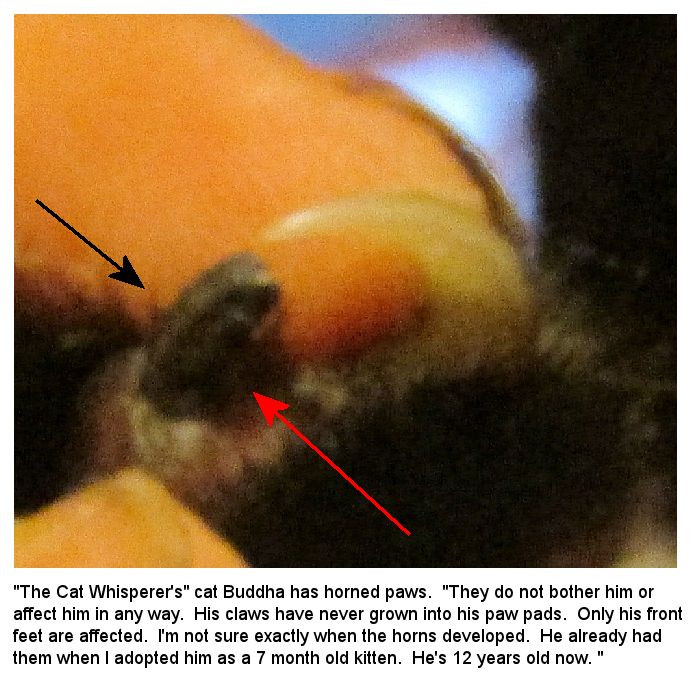
Natasha has a polydactyl cat (7 front, 5 back) that also has horned pawpads. The keratin-like "horns" or calluses do grow (probably as the hardened skin is not shed or worn away) and were first noticeable at 6-7 months old because one had grown very long and looked like another claw growing out of his pad and curving upwards towards his natural claw. Octavius gnaws them down himself and they don't appear to cause any discomfort or interference.
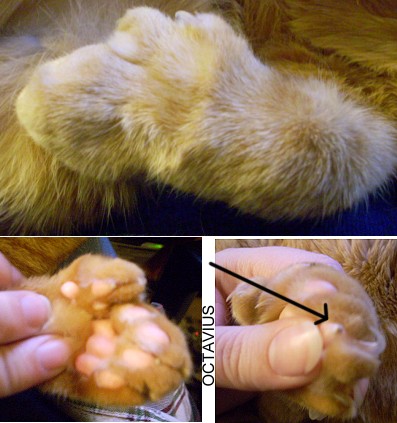
2016. Cat Okita sent some photos of her nearly 5 month old random-bred cat from the Fort Lauderdale, Florida, USA area. He is e’s another 4 + (1) + 1 + (1) in front, and 5 in back — but only has horns on his 7th toe (i.e. mitten foot where extra claws are tucked between the normal foot and "thumb" - the numbers in brackets mean extra claws that aren't on a fully developed toe). He also has "horns" that are clearly dead/built up skin and can be safely clipped. The claw on the horned pad is thick and heavy and is probably two fused claws. Toes 5 and 7 have non-retractile claws and a pad.

At the same time as reporting horned paws (2004), Sylvia Gallus wrote of another cat's unusual "palm" pads on three of his paws. Though they seem swollen, they don't contain any fluid and are not painful. They feel squishy, like water balloons. Her vet has not seen this before. Common causes of swollen pads include skin conditions, infections and oedema from injury, but in this case the paws aren't painful and three paws are affected, but not the fourth. An x-ray or biopsy should determine what the puffy tissue is. Possibly it is due to unusual fatty deposits. Nifty was a stray adopted off of the street in February 2005; he was originally pretty wild, but has since become much more sociable. His feet aren't as swollen as they were when Sylvia first met him. The "swelling" has very gradually subsided although his pads still feel squishy. Since the condition was not painful, the vet decided not to biopsy the tissue. Nifty sometimes limps slightly, even when the paws aren't swollen. Unlike most cats, Nifty has a "pacer" gait where both legs on the same side move together, unlike a "trot" where the diagonal legs move together. This makes him sway side to side when he walks. Gait, appears to be genetically determined, but is better studied in horses than in cats.
